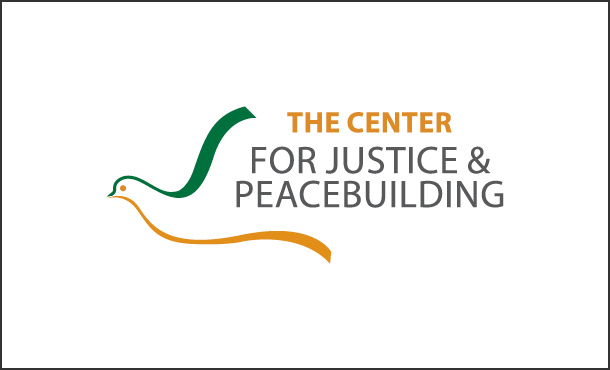Eastern Mennonite University’s Center for Justice and Peacebuilding recently released a new logo – a definitive rebranding that will carry the center’s renowned academic and training programs into the future.
Since 1994, the center has utilized components of the university’s parent brand, with a more recent adoption of an icon, the dove carrying an olive branch. The new logo retains traditional symbolism yet integrates a different font style and color spectrum.
“In the past 20 years, The Center for Justice and Peacebuilding has had a distinctive role on campus, even as it has helped raise EMU’s profile internationally through its leading-edge peacebuilding work,” says J. Daryl Byler, the center’s executive director. “This first-ever CJP logo symbolizes our unique identity, as we seek to balance domestic peacebuilding efforts with our international work.”
More than 20 years of growth
Since its launching in 1994 as one of the nation’s first academic peacebuilding graduate degree programs, CJP has continued to offer practice-oriented studies towards a master’s in conflict transformation. The Summer Peacebuilding Institute (SPI), which also started in 1994, now attracts approximately 150-200 international peacebuilders in four seven-day sessions. Programmatic growth over the years has led to additional certificate and training programs, such as Strategies for Trauma Awareness and Resilience (STAR) and the Women’s Peacebuilding Leadership Program. The center will soon launch a master’s degree in restorative justice.
“The word ‘Mennonite’ and the acronyms EMU, CJP, SPI have significant brand name recognition around the world as places to study peacebuilding,” said EMU’s director of marketing and communications Andrea Schrock Wenger. “We want to build on that so greater numbers of people can join in this community of learning that equips people to serve the common good.”
The new logo, developed by brand ID manager Jon Styer, incorporates a dove, a symbol that has been part of CJP’s visual identity since its inception more than two decades ago.
The brandmark highlights the center’s Anabaptist links – the dove is used in other Mennonite-related organizations – but includes design elements that highlight the center as a community of practitioners and learners around the core concepts of justice and peacebuilding.
The CJP difference
The logo design was one result of a thorough assessment of CJP’s identity, vision and mission completed in collaboration with Gravity Group, a Harrisonburg, Virginia-based brand and marketing consultancy.
“CJP was an ideal program to work with,” says Gravity Group creative director Christian Perritt, with more than 20 years’ experience in the field. “Rarely do you find a brand with such consistent feedback regarding the brand’s story. While it took some hard work to hone in and articulate the key differentiators of CJP’s brand, everyone ultimately embraced the work. This gives incredible clarity for CJP going forward.”
The three-stage review, which took approximately three months in the fall of 2014, included analysis of material gathered from CJP’s academic programs, as well as STAR assessment reports and SPI attendee interviews. Additionally, two focus groups with representation from across CJP programs were convened.
Four key areas differentiate EMU’s master’s level peacebuilding studies from the dozens of others now available, according to the data.
CJP acts as a nexus for a global community of learning, with more than 500 graduates working around the world in different settings. Since 1994, SPI has attracted approximately 2,800 students of diverse faiths from 120 countries for academic instruction and cultural exchange.
CJP’s core peacebuilding, conflict transformation, and restorative justice curriculum remains unique in its hands-on practice-based style of learning. Coursework is led by faculty with years of experience in international peacebuilding and community development. All graduates complete practicums and report on learnings in a capstone presentation.
A focus on restorative justice and the implicit healing power in communicative, relational practices – first developed by retiring professor Howard Zehr – lies at the heart of CJP’s core values.
Finally, CJP operates out of a values-based paradigm that integrates the Anabaptist values.
“People from many faith traditions are comfortable at EMU,” notes Byler. “In fact, other faith traditions, and even those of no professed faith, resonate with our core values and respect our Christian identity even as we learn from the valuable perspectives they bring to this community.”
The new logo design is being used on print pieces beginning in May. By late summer, a revamped interactive website featuring the new brand identification will be launched with tools for networking among the more than 3,000 alumni of CJP programs.
